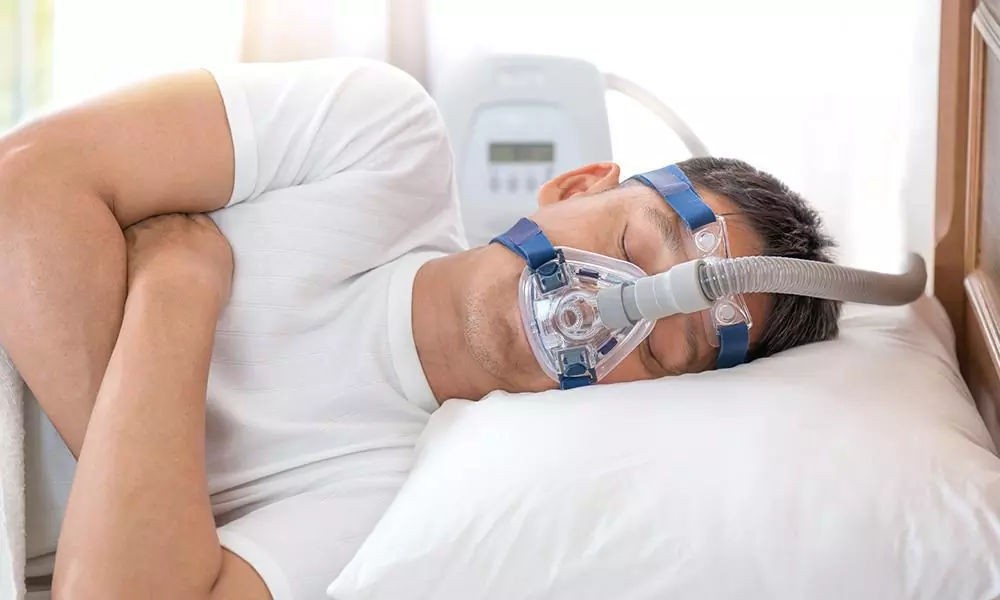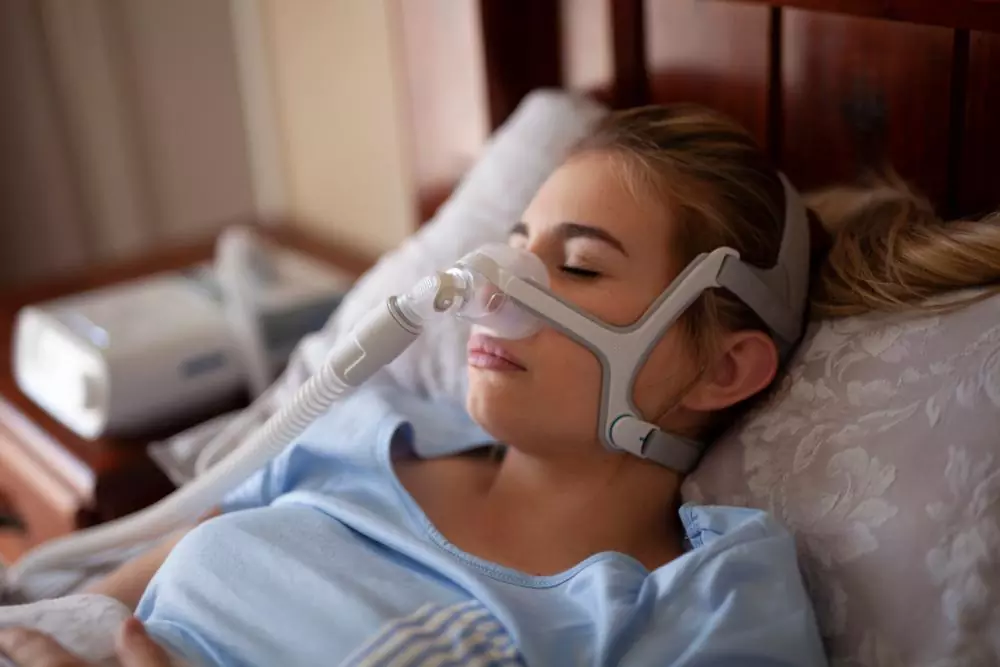Have you been a loud snorer for the majority of your life?
Do you experience breathing difficulties while lying down at night, followed by early morning headaches and sleepiness throughout the day?
If these issues have been bothering you for a long, you are most likely to be suffering from a condition termed OSA. Better termed as Obstructive Sleep Apnea (1), the physical ailment requires an extensive stretch of treatment, presided over by the CPAP machine.
CPAP, or continuous positive airway pressure, is a treatment for sleep apnea that uses a machine to deliver a constant flow of pressurized air to the airway. This helps keep the airway open during sleep, reducing the number of apnea events and improving overall sleep quality.
Before we throw some light on what a CPAP machine is, it is necessary to understand that it is a non-invasive tool to facilitate seamless breathing, which in turn helps you sleep better at night.
CPAP Machine: Significance

While OSA is a topic for subsequent discussion, we shall now be focusing on the functionalities of a CPAP machine. As the name suggests, Continuous Positive Airway Pressure is a handful when applying milder levels of pressure to the upper airway is concerned.
OSA ensures that when a person is fast asleep, he or she doesn’t have any control over the throat airways, leading to repeated breathing pauses. With the airways blocked, there isn’t any seamless passage of air on an involuntary basis, eventually leading to sleep disruptions, snoring, and a host of other relative issues.
This is where a CPAP machine comes into the mix as it allows you to administer extended spells of treatment for OSA. Moreover, the CPAP is most relevant in the post-pandemic era as the COVID-19 virus attacks your lungs and constricts your breathing as a part of the proliferation plan. Therefore, individuals suffering from OSA should be even more careful during this post-pandemic phase and immediately get themselves a CPAP Machine.

Components of CPAP machine
From strictly a structural point-of-view, a CPAP machine is all about three essential parts, including the Motor for processing the air, Hose for supplying the same, and a dedicated mask that curates the air supply and redirects it to the desired target.
- The motor: It generates pressurized air, which is delivered to the user through the hose and mask.
- The hose: Also known as the tubing, the hose is a flexible tube that connects the CPAP machine to the mask. It is typically made of a soft, pliable material that is easy to handle and maneuver.
- The mask: It fits over the nose or mouth, or both, and is held in place with straps.
The pressure of the air is set by a healthcare provider based on the user’s specific needs.
How does a CPAP machine works

The process starts when the motorized turbine pushes the air at room temperature, right into the filtered chamber. The residual air, free of impurities, dust, and other anomalies, is then adequately pressurized to match the cavity standards.
A good CPAP machine is capable of achieving the perfect pressure levels sans hassles and ensures that the air doesn’t lose out on compressive properties while being redirected through to the humidification chamber.
However, if you are considering a CPAP machine, you need to realize that humidification is an optional trait and the extent or even application depends on the local climatic conditions. Patients who often complain of blocked and dried-up nasal passages due to conditions like OSA and Rhinitis require air humidification.
- The CPAP Hose is the component that delivers air right from the Motor. While the Hose doesn’t have a lot of technical insights to account for, the material, thickness, and orientation might be scrutinized before making the purchase.
- For instance, you can always persist with a non-heated CPAP hose with standard or enlarged diameter or opt for the heated Hose, empowered with copper coils for heat retention.
- Furthermore, you are at liberty to choose between a standard hose with an internal diameter close to 19mm and a slim hose measuring 15mm in thickness.
- Besides, if you want to replace the CPAP hose at some point in time, check the compatible diameter for the concerned machine, followed by the inclusion of rubber ends.
The CPAP mask happens to be the last log in the wheel, instrumental in delivering clean and purified air right into the airway, sitting at the back of the throat. The additional supply of air helps with breathing and mitigates long and short-term threats.
If you are interested in learning more about the humidifier, this optional attachment lends a moisturizing effect to the pressurized air. For the humidifier to work well, consider using distilled water as the humidifying agent, precisely to keep impurities and mineral accumulation at bay.
This can greatly improve sleep quality and reduce the number of apnea events, which are periods of time when breathing stops or becomes shallow during sleep.
Benefits of CPAP therapy:
There are many benefits to using CPAP therapy for sleep apnea. Some of the main benefits include:
- Improved sleep quality: CPAP therapy can help users sleep more soundly and wake up feeling more refreshed.
- Reduced apnea events: CPAP therapy can significantly reduce the number of apnea events, which are periods of time when breathing stops or becomes shallow during sleep.
- Improved overall health: CPAP therapy can help reduce the risk of complications associated with sleep apnea, such as high blood pressure and heart problems. It can also improve symptoms such as daytime fatigue and difficulty concentrating.
- Comfort: Many CPAP machines now have features such as humidifiers and heated tubes to make the therapy more comfortable for users.
- Convenience: CPAP therapy can be used in the comfort of one’s own home, and modern machines are often small and portable, making it easy to use while travelling.
Side effects of CPAP therapy
While CPAP therapy is generally well tolerated, some users may experience side effects. Using a CPAP (Continuous Positive Airway Pressure) machine can have potential side effects, although most are minor and can be easily managed. Some common side effects of using a CPAP machine include:
- Dry mouth and nasal passages
- Nasal congestion
- Skin irritation
- Aches and pains
- Sleep disruption
- Feelings of confinement or claustrophobia
If you experience any side effects while using CPAP therapy, it is important to speak with your healthcare provider. They can help you make adjustments to the machine or treatment plan to help alleviate any side effects you may be experiencing.
Maintenance and care of CPAP machines
It is important to properly maintain and care for your CPAP machine in order to ensure that it is working effectively and safely. Here are some tips for maintaining and caring for your CPAP machine:
- Clean the mask and tubing regularly: Wash your mask and tubing every week with mild soap and warm water, and let them air dry.
- Clean the water chamber: Empty and dry the water chamber every day, and wash it every week with mild soap and warm water.
- Replace the filter: Check the manufacturer’s recommendations for how often to replace the filter, and replace it as needed.
- Keep the machine clean: Wipe the exterior of the machine with a damp cloth every week.
- Store the machine properly: When not in use, store the machine in a dry place away from direct sunlight.
- Have the machine serviced regularly: It is recommended to have your CPAP machine serviced by a professional every 6 to 12 months to ensure it is working properly.
By following these tips, you can help extend the life of your CPAP machine and ensure that it is working effectively.
Also read: How to clean CPAP machine using vinegar
Tips and best practices for using CPAP therapy
- Use the CPAP machine every night: It is important to use the CPAP machine every night, even if you feel rested. Skipping even a single night can disrupt your treatment.
- Use the machine consistently: Try to use the machine for the same amount of time every night. This will help you get used to the therapy and make it more effective.
- Adjust the mask and straps: Make sure the mask fits properly and is comfortable. It is also important to adjust the straps so that the mask is secure, but not too tight.
- Find the right pressure: The pressure of the air coming from the machine may need to be adjusted to ensure that it is effective. Talk to your doctor or sleep specialist if you are having difficulty finding the right pressure.
- Try different masks: If you are having trouble finding a comfortable mask, try using a different style or size. There are many different types of masks available, so it may take some trial and error to find the one that works best for you.
Bottom-Line
Adjusting to a CPAP machine might take some time. However, if you have any kind of nasal or airway-specific blockage, the CPAP machine is probably your best bet for getting a good night’s sleep. Moreover, if the same has been prescribed by the doctor, and you wish to be monitored continuously, consider a machine that supports automatic troubleshooting, online data sharing, and other advanced features.
Lastly, once you have started relying on a CPAP machine, do not consider discontinuing unless instructed by the physician.

